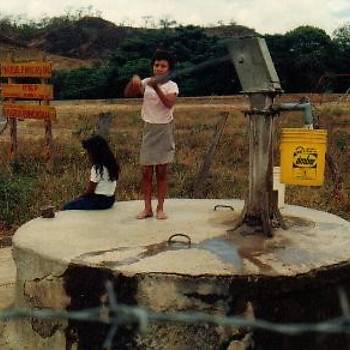Lessons learned.
The Mark II hand pumps emerged since there was a need for a hand pump that was more durable than those available at the time and there was a need for a pump for boreholes. It was a public domain pump produced by many companies. Some companies reduced prices by reducing quality. Especially in Africa, this has led to many failures and high repair costs and an estimated 35% of these pumps are not functioning. This pump was meant to be a VLOM (Village Level Operation and Maintenance) pump. So a pump that, after some training, could be maintained and repaired by community members or a village technician. Especially in Africa, this did not work in many situations. For instance to replace a piston washer all the pump pipes had to be dismantled which requires skilled technicians and specific tools. Another limitation of this pump was that the pump pipes and pump rods corroded easily in water with a PH lower than 7. Lesson learned include
- This pump was not a VLOM type of pump.
- Although cheap, Mark 2 pumps were costly in repairs, especially the low-quality pumps.
History
This pump is installed on top of a drilled well or borehole and lifts water from the bottom of the well through repeatedly moving the pump handle up and down. It was designed in the 1970s in a joint effort between the Government of India, UNICEF, and The World Health Organization (WHO) to address the severe drought and a water shortage affecting India during that period and to prevent the evacuation of villages to refugee camps. Prior to the pumps design, poor quality cast-iron replicas of pumps used in Europe and North America to support a single family were used. While these types of pumps in the US might have been used by a farming family three or four times a day, those in India were used incessantly by an entire community, with women and children lining up to use each pump from dawn till dusk. Not surprisingly, the pumps frequently broke down. When UNICEF did a survey of boreholes and pumps in two Indian states, it found that 75 percent of the pumps were out of action. The requirements for the pump included the need for a design simple enough to be manufactured in unsophisticated workshops, easy to maintain, and cost no more than US$200 (in 1970s dollars). The Mark II was based on the Sholapur pump, the most durable pump at that time, designed by Swedish volunteer, engineer, and inventor Oscar Carlsson of the Sholapur Well Service, operating under the Mission Covenant Church of Sweden and the Hindustani Covenant Church of India. In just 20 years, 1 million of the pumps had been manufactured and installed in the developing world. An Indian magazine listed India Mark II hand pump as one of the defining inventions of the country. The Mark II became the state-of-the-art in water hand pumps and by 1998 there were 62 manufacturers with an annual production capacity of over 300,000 pumps. In 2020 there are 3-5 million of these pumps in India alone and it is exported to > 40 countries. Since it was a public domain pump it could be and was copied by companies who did not take in account the quality assurance procedures. Many pumps were exported from India to Africa including low-quality pumps. Recently WaterAid and others are developing a MK pump model with a large diameter of the pump pipes (rising main) so no more need to dismantle the pump pipes. This is similar to the Afridev and Volanta pump models.
Future of the Mark 2 pump
The major criticism of the India Mark II is that its design makes it difficult to repair at the village level and hence, without government support, NGO intervention, or community savings systems in place, the pump is more susceptible to extended periods of non-function or permanent failure. Lower upfront hardware costs and widespread adoption of the Mark II pump makes replacement parts more accessible. Unfortunately, higher maintenance costs and the frequency of parts that need to be replaced can make the pump financially unsustainable in a poor community. More reliable pumps have been developed to be maintained at the local level: (VLOM). The India Mark III, Afridev, and Bluepump are the most common VLOM pumps. The pumps incorporate the use of larger PVC riser mains to allow for the pump cylinder to be removed without lifting the rising main out of the borehole. This makes maintenance on the pumps easier but the initial cost for the pipes can be twice as much. Routine maintenance is still required and maintaining funds for replacement parts is still necessary. Without the need for a specialized pump mechanic, these newer pump designs can provide longer-lasting sustainable access to drinking water. Unfortunately, some countries have restricted importation and installation of these pumps citing the need to standardize pumps to reduce cost and ensure an adequate supply of replacement parts. The government of Uganda, for example, enforces standardization by placing high tariffs on pumps other than a variant of the India Mark II, known as U2.
Information:
The book the handpump option http://documents.worldbank.org/curated/en/299321468765272889/pdf/multi0page.pdf
Wikipedia https://en.wikipedia.org/wiki/India_Mark_II
Akvopedia https://en.wikipedia.org/wiki/India_Mark_II
Manuals on the website of RWSN /SKAT
http://www.rural-water-supply.net/en/resources/details/603
Article. History of 3 hand pumps https://www.rural-water-supply.net/en/resources/details/475
Article. India Hand pump revolution. https://www.rural-water-supply.net/en/resources/details/436
